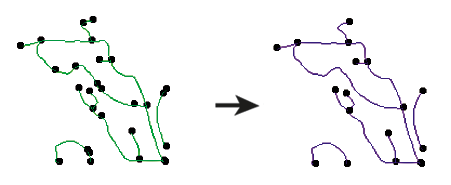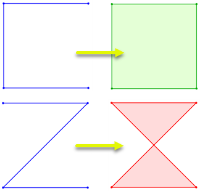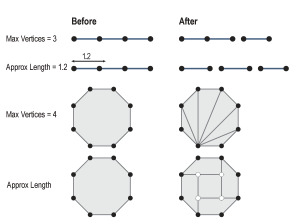FME Transformers: 2025.2
Splits path geometry into its component line and/or arc segments.
Typical Uses
-
Decomposing PathBuilder or CurveFitter output
-
Preparing geometry for formats that do not support paths
How does it work?
The output features may have either line or arc geometry, and retain the input path’s attributes unless a Segment List list attribute is provided, as shown in the Paths and List Attributes example below.
Each segment’s number within the path can be added as an attribute.
Features with non-path geometry are passed through unchanged.
Note that path geometry is not supported in all output formats. See also: Line , Arc, and Path geometry.
Examples
In this example, we have a path feature representing a transit line. The path is made up of numerous arc and short line segments.
We want to split this path into its component parts.

The feature is routed into a PathSplitter.

In the parameters dialog, the default settings are kept. Note that the Segment List parameter is not available, as the input feature has no list attribute on it.
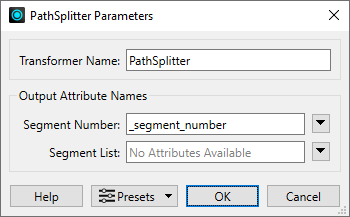
One feature is output for each path segment, with a new attribute containing the segment number.
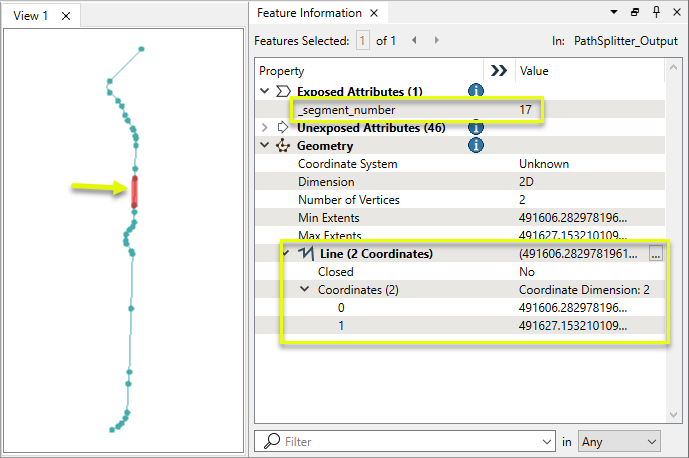
If the individual segments of a longer line have varying attributes - fluctuating speed limits on a highway, for example - those attribute values can be preserved as a list attribute on path geometry and later retrieved when the path is split back into its component segments.
Creating a path and preserving attributes
In this example, we have a set of short lines that make up a bike path. The attribute values can vary from segment to segment.
We want to treat the bike path as a single piece of geometry, but retain the original segment details - both geometry and attribution.

The lines are routed into a PathBuilder.

In the parameters dialog, Generate List is enabled, the list is named SegmentAttributes, and All Attributes are added to list.

The output path has a SegmentAttributes list with 11 list items, and its geometry is a Path with 11 segments.
Note the difference between the attribute values on list items 9 and 10.
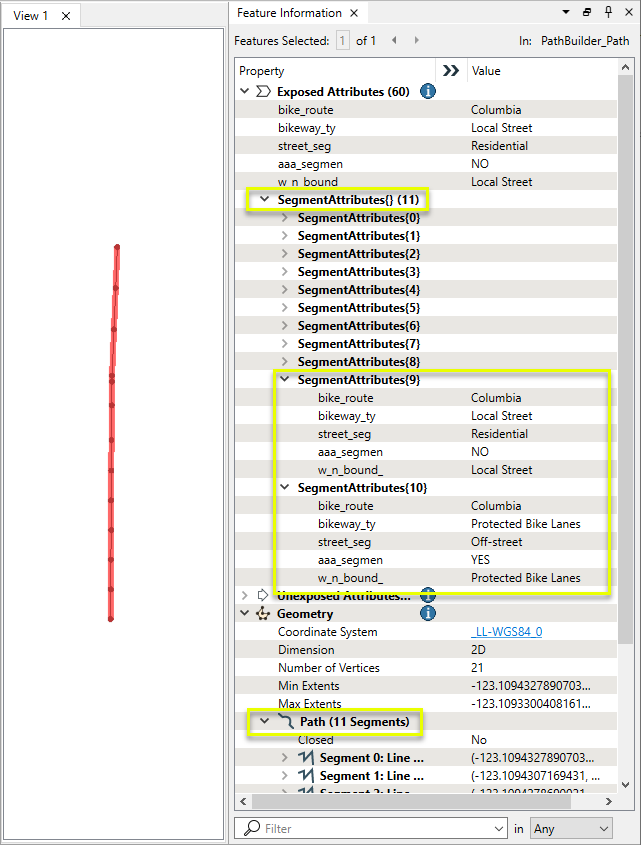
Splitting a path and recovering attributes
In this example, we want to recover the original geometry and attribution from the path with a list attribute created in the example above.
Note the path geometry with 11 segments and the SegmentAttributes list with 11 items.
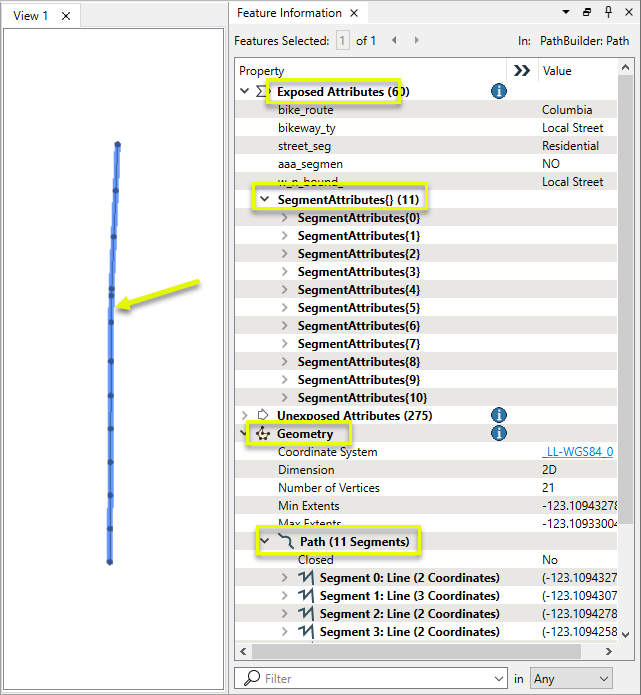
The path is routed into a PathSplitter.

In the parameters dialog, Segment List is set to the list attribute SegmentAttributes.

The output features receive attribute values according to path segment and list item pairs.

Usage Notes
-
The PathBuilder, Curvefitter, and LineExtender can output path geometries.
-
Aggregate geometry also treats multiple geometries as a single unit, but path geometry ensures that the components are contiguous and connected.
-
This transformer and the ArcStroker may be useful in preparing geometry for output formats with limited geometry support.
-
The GeometryCoercer, DonutHoleExtractor, and Deaggregator may be useful in preparing geometry for the PathSplitter.
Creating and Modifying Linear Features
These transformers work with lines in a variety of ways.
|
Transformer |
Use this to... |
Transformer Description |
|---|---|---|
|
Create one or more new features with box geometry of a specific size and position (when Geometry Object is Line). |
Creates features using the parameters supplied, and sends them into the workspace for processing. |
|
|
Create simple lines from lines and/or points. |
Connects sequential point and/or line features to create line or area geometry.
|
|
|
Combine adjoining lines into longer lines or complex paths, with more advanced geometry handling options than the LineBuilder. |
Connects line features that meet at common start or end points to create longer lines or paths.
|
|
|
Combine arcs and lines into longer paths. |
Connects sequential line and/or arc features to create path geometry, preserving input segments. |
|
|
Convert linear features into areas. |
Converts a linear feature to an area by connecting the end point to the start point.
|
|
|
Extend linear geometry. |
Extends line, arc, or path features at both ends by a specified length.
|
|
|
Chop features into smaller features, breaking them at their existing vertices. |
Chops line, arc, path, or area features into smaller features based on number of vertices or approximate length.
|
|
|
Break a path into its component segments (lines and arcs). |
Splits path geometry into its component line and/or arc segments. |
|
|
Shorten linear geometry. |
Shortens linear geometry by cutting off the ends. |
|
|
Intersect lines and areas. |
Overlays lines and areas, intersecting geometry and sharing attributes.
|
|
|
Intersect lines and lines. |
Overlays lines on lines, intersecting geometry, sharing attributes, and producing intersection points. |
|
|
Find where points lay on lines. |
Overlays points on lines, splitting lines and sharing attributes. |
Configuration
Input Ports
Features with path geometry and (optionally) list attributes.
Output Ports
One feature for each segment of the input path.
Input features with non-path geometry are output here unchanged.
Parameters
|
Segment Number |
Name the attribute to contain the segment number of the output feature. |
|
Segment List |
If the input has a list attribute containing attribute values corresponding to the path segments, it may be specified here. List item attributes and values are applied to the output features. See the Paths and List Attributes example above. |
Editing Transformer Parameters
Transformer parameters can be set by directly entering values, using expressions, or referencing other elements in the workspace such as attribute values or user parameters. Various editors and context menus are available to assist. To see what is available, click  beside the applicable parameter.
beside the applicable parameter.
Defining Values
There are several ways to define a value for use in a Transformer. The simplest is to simply type in a value or string, which can include functions of various types such as attribute references, math and string functions, and workspace parameters.
Using the Text Editor
The Text Editor provides a convenient way to construct text strings (including regular expressions) from various data sources, such as attributes, parameters, and constants, where the result is used directly inside a parameter.
Using the Arithmetic Editor
The Arithmetic Editor provides a convenient way to construct math expressions from various data sources, such as attributes, parameters, and feature functions, where the result is used directly inside a parameter.
Conditional Values
Set values depending on one or more test conditions that either pass or fail.
Parameter Condition Definition Dialog
Content
Expressions and strings can include a number of functions, characters, parameters, and more.
When setting values - whether entered directly in a parameter or constructed using one of the editors - strings and expressions containing String, Math, Date/Time or FME Feature Functions will have those functions evaluated. Therefore, the names of these functions (in the form @<function_name>) should not be used as literal string values.
| These functions manipulate and format strings. | |
|
Special Characters |
A set of control characters is available in the Text Editor. |
| Math functions are available in both editors. | |
| Date/Time Functions | Date and time functions are available in the Text Editor. |
| These operators are available in the Arithmetic Editor. | |
| These return primarily feature-specific values. | |
| FME and workspace-specific parameters may be used. | |
| Creating and Modifying User Parameters | Create your own editable parameters. |
Table Tools
Transformers with table-style parameters have additional tools for populating and manipulating values.
|
Row Reordering
|
Enabled once you have clicked on a row item. Choices include:
|
|
Cut, Copy, and Paste
|
Enabled once you have clicked on a row item. Choices include:
Cut, copy, and paste may be used within a transformer, or between transformers. |
|
Filter
|
Start typing a string, and the matrix will only display rows matching those characters. Searches all columns. This only affects the display of attributes within the transformer - it does not alter which attributes are output. |
|
Import
|
Import populates the table with a set of new attributes read from a dataset. Specific application varies between transformers. |
|
Reset/Refresh
|
Generally resets the table to its initial state, and may provide additional options to remove invalid entries. Behavior varies between transformers. |
Note: Not all tools are available in all transformers.
For more information, see Transformer Parameter Menu Options.
Reference
|
Processing Behavior |
|
|
Feature Holding |
No |
| Dependencies | None |
| Aliases | |
| History |
FME Online Resources
The FME Community and Support Center Knowledge Base have a wealth of information, including active forums with 35,000+ members and thousands of articles.
Search for all results about the PathSplitter on the FME Community.
Examples may contain information licensed under the Open Government Licence – Vancouver, Open Government Licence - British Columbia, and/or Open Government Licence – Canada.

